Determination of Priority Study Areas for Coupling CO2 Storage and CH4 Gas Hydrates Recovery in the Portuguese Offshore Area
Abstract
:1. Introduction
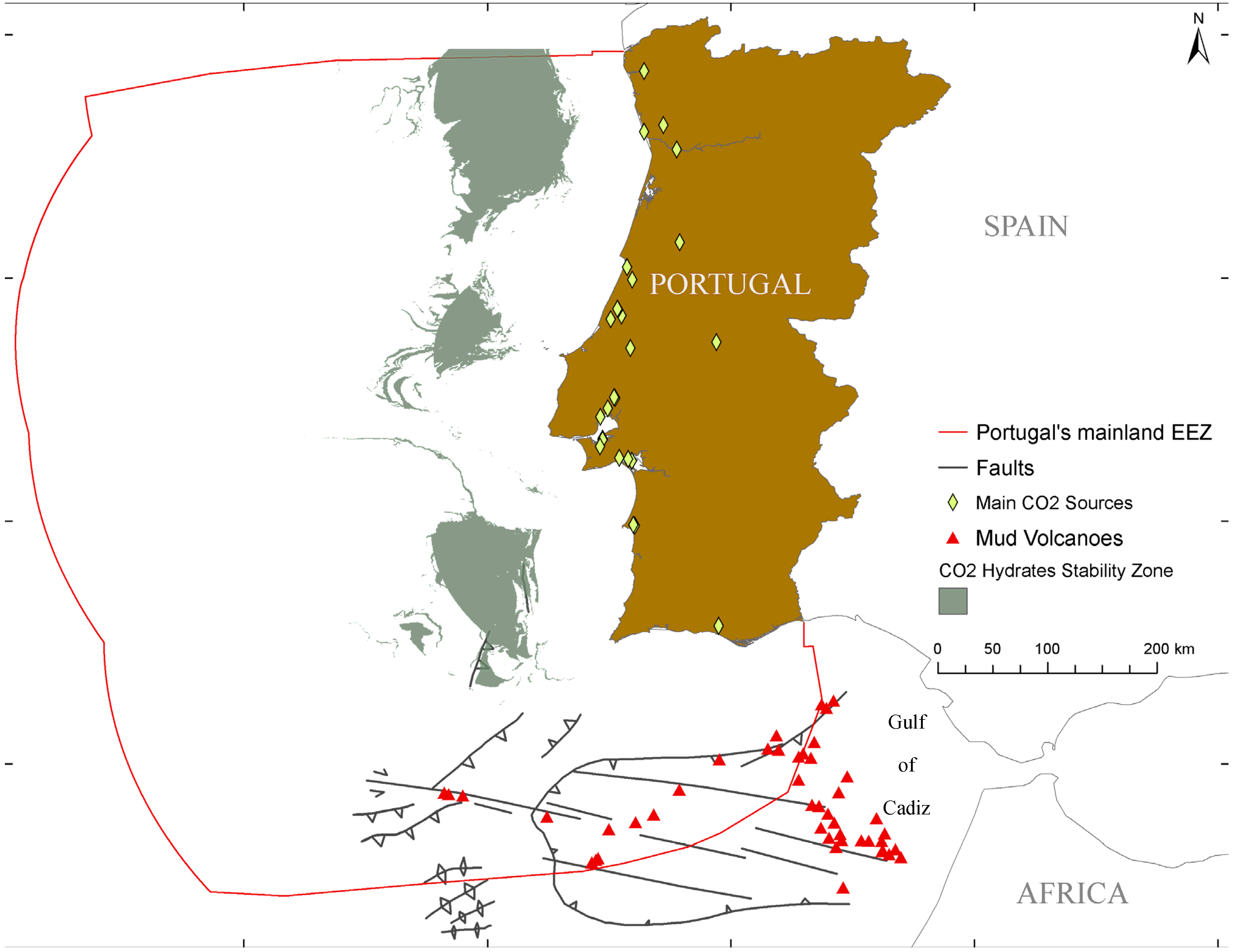
2. Background
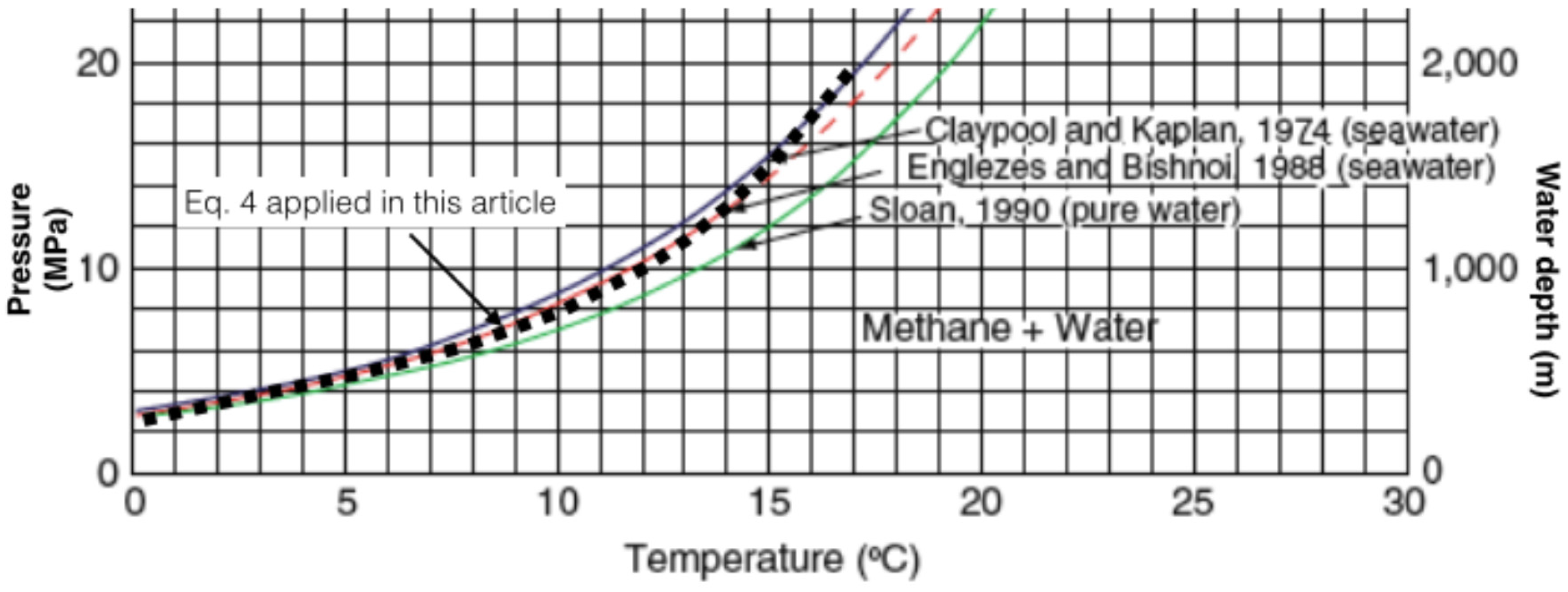
3. Methodology
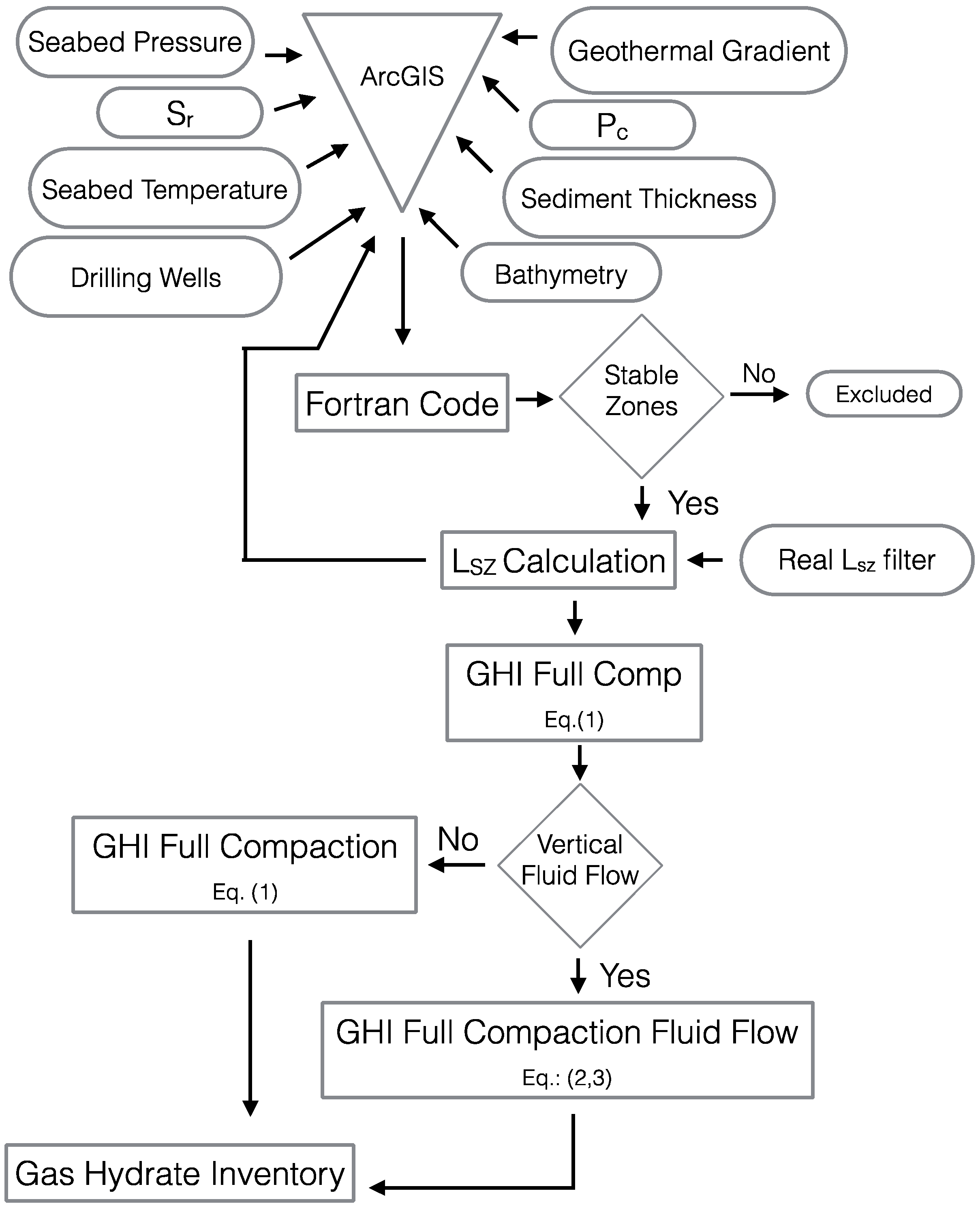
4. Results and Discussion
4.1. Thickness of Gas Hydrates Stability Zone (Lsz)
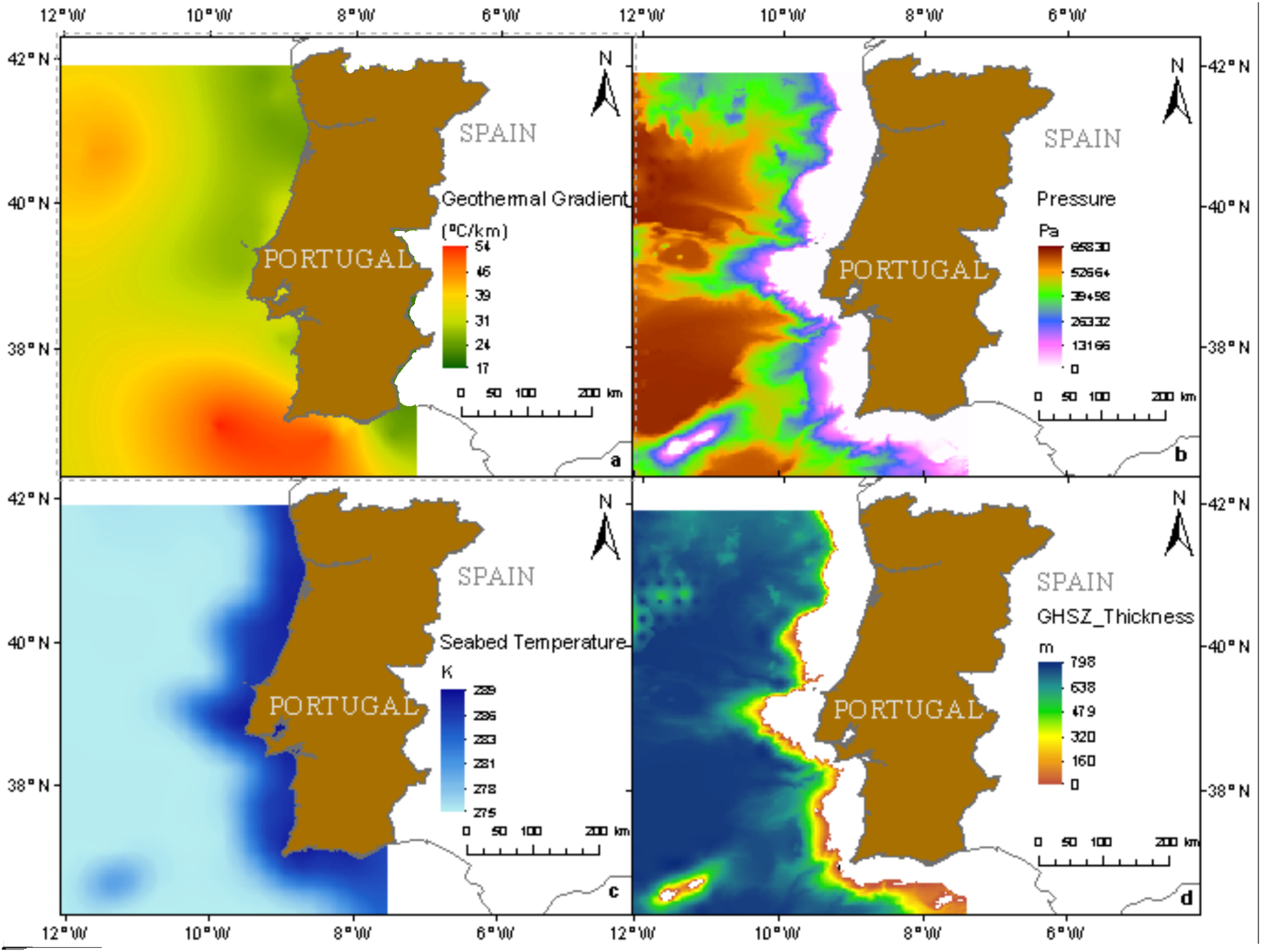
4.2. Sedimentation Rate (Sr)
| Lat dd | Long dd | Sr cm/ky | Lat dd | Long dd | Sr cm/ky | Lat dd | Long dd | Sr cm/ky | Reference |
|---|---|---|---|---|---|---|---|---|---|
| 36.69 | −11.43 | 0.389 | 37.70 | −9.47 | 11.620 | 37.75 | −9.73 | 20.400 | Thiede et al [30] |
| 35.35 | −10.42 | 0.969 | 37.61 | −9.28 | 5.300 | 37.71 | −9.23 | 7.100 | |
| 40.96 | −10.72 | 2.891 | 37.92 | −10.85 | 7.940 | 37.70 | −9.47 | 11.620 | |
| 36.69 | −11.43 | 0.389 | 37.72 | −10.55 | 12.040 | 37.61 | −9.28 | 5.300 | |
| 35.35 | −10.42 | 0.969 | 37.70 | −9.77 | 19.000 | 37.92 | −10.85 | 7.940 | |
| 40.96 | −10.72 | 4.167 | 37.65 | −9.53 | 7.550 | 37.72 | −10.55 | 12.040 | |
| 37.65 | −9.53 | 7.550 | 37.68 | −10.08 | 16.180 | 37.70 | −9.77 | 19.000 | |
| 37.75 | −9.73 | 20.400 | 37.71 | −9.23 | 7.100 | 34.80 | −10.25 | 2.900 | |
| 37.77 | −10.18 | 16.000 | 37.68 | −10.08 | 16.180 | - | - | - | Broecker et al. [31] |
| 40.58 | −9.86 | 35.600 | 37.77 | −10.18 | 33.150 | - | - | - | Thomson et al. [32] |
| 34.89 | −7.82 | 4.864 | 34.91 | −7.58 | 4.896 | 34.86 | −8.13 | 3.210 | Sarnthein, Michael (2006) [33] |
| 39.04 | −10.66 | 5.917 | - | - | - | - | - | - | Voelker et al. [34] |
| 38.63 | −9.51 | 0.001 | 38.63 | −9.51 | 0.001 | - | - | - | Alt-Epping, Ulrich [35] |
| 41.23 | −9.07 | 0.240 | 41.84 | −8.99 | 0.070 | 41.21 | −9.04 | 0.350 | Recent sedimentation and sedimentary budgets on the western Iberian shelf |
| 41.81 | −9.08 | 0.170 | 41.17 | −9.03 | 0.420 | 41.24 | −9.03 | 0.410 | |
| 41.84 | −9.11 | 0.200 | 41.20 | −9.04 | 0.300 | 41.32 | −9.00 | 0.170 | |
| 41.78 | −9.07 | 0.230 | 41.85 | −9.07 | 0.140 | - | - | - |
4.3. Particulate Organic Carbon (Pc)
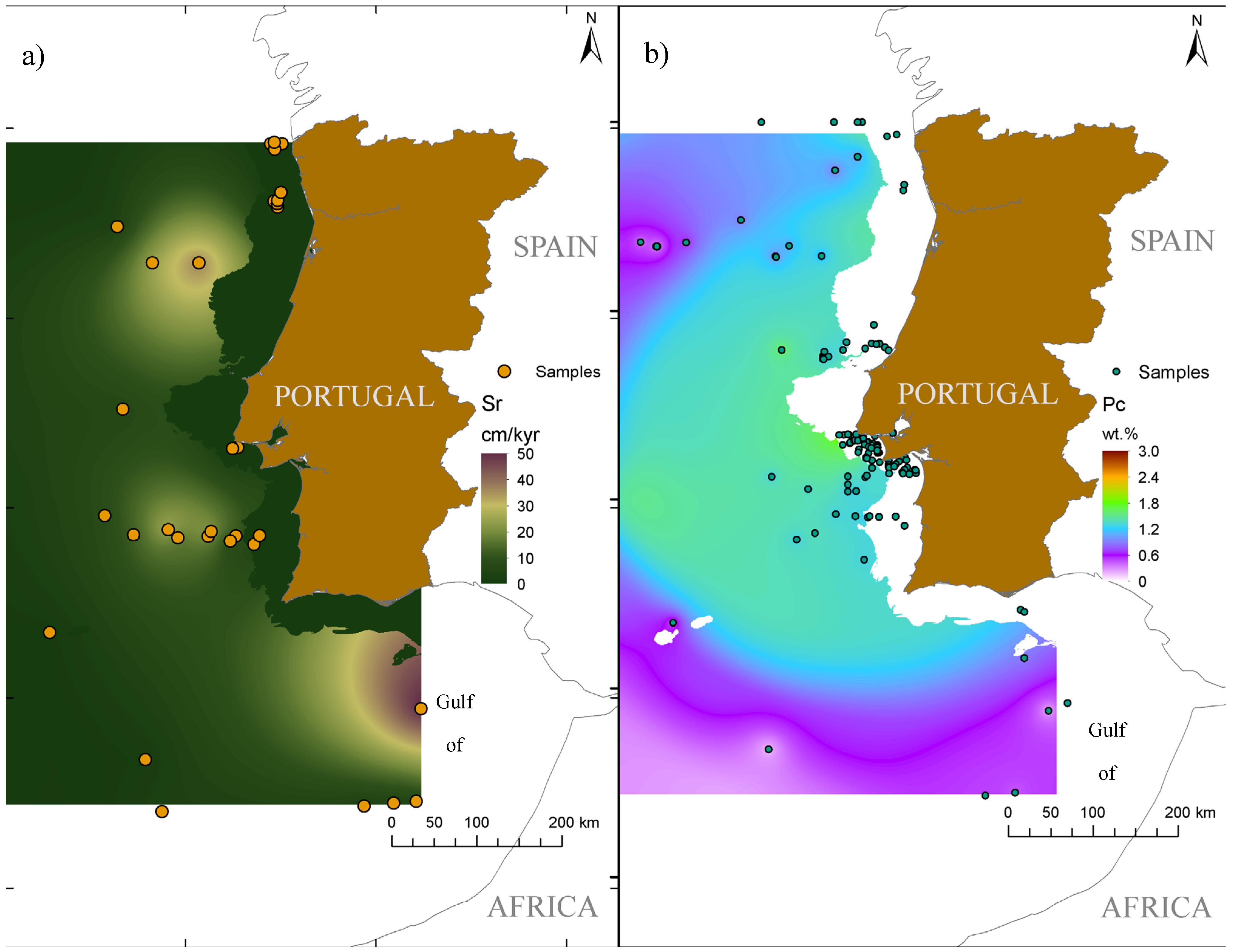
4.4. Gas Hydrates Inventory (GHI)
4.4.1. Full Compaction Scenario
| Average GHI (kg·m−2) | Vertical Fluid Flow with Full Compaction Scenario (cm·yr−1) | |||||
| Parameter Variation | q = 0.005 | q = 0.01 | q = 0.015 | q = 0.02 | Parameter Variation | |
| 22.11 | 22.13 | 72.69 | 147.65 | 282.27 | ||
| 22.13 | 75.7 | 151.11 | 286.55 | Pc 10% wt.% | ||
| 22.13 | 68.08 | 137.5 | 262.19 | Sr 10% (cm·kyr−1) | ||
| Average GHI (MtC) | 493.04 | 493.04 | 3590.87 | 7293.92 | 13947.23 | |
| 840.49 | 493.02 | 3739.71 | 7465.06 | 14158.53 | Pc 10% wt.% | |
| 769.62 | 493.04 | 3362.88 | 6792.66 | 12954.94 | Sr 10% (cm·kyr−1) | |
4.4.2. Vertical Fluid Flow and Full Compaction Scenario
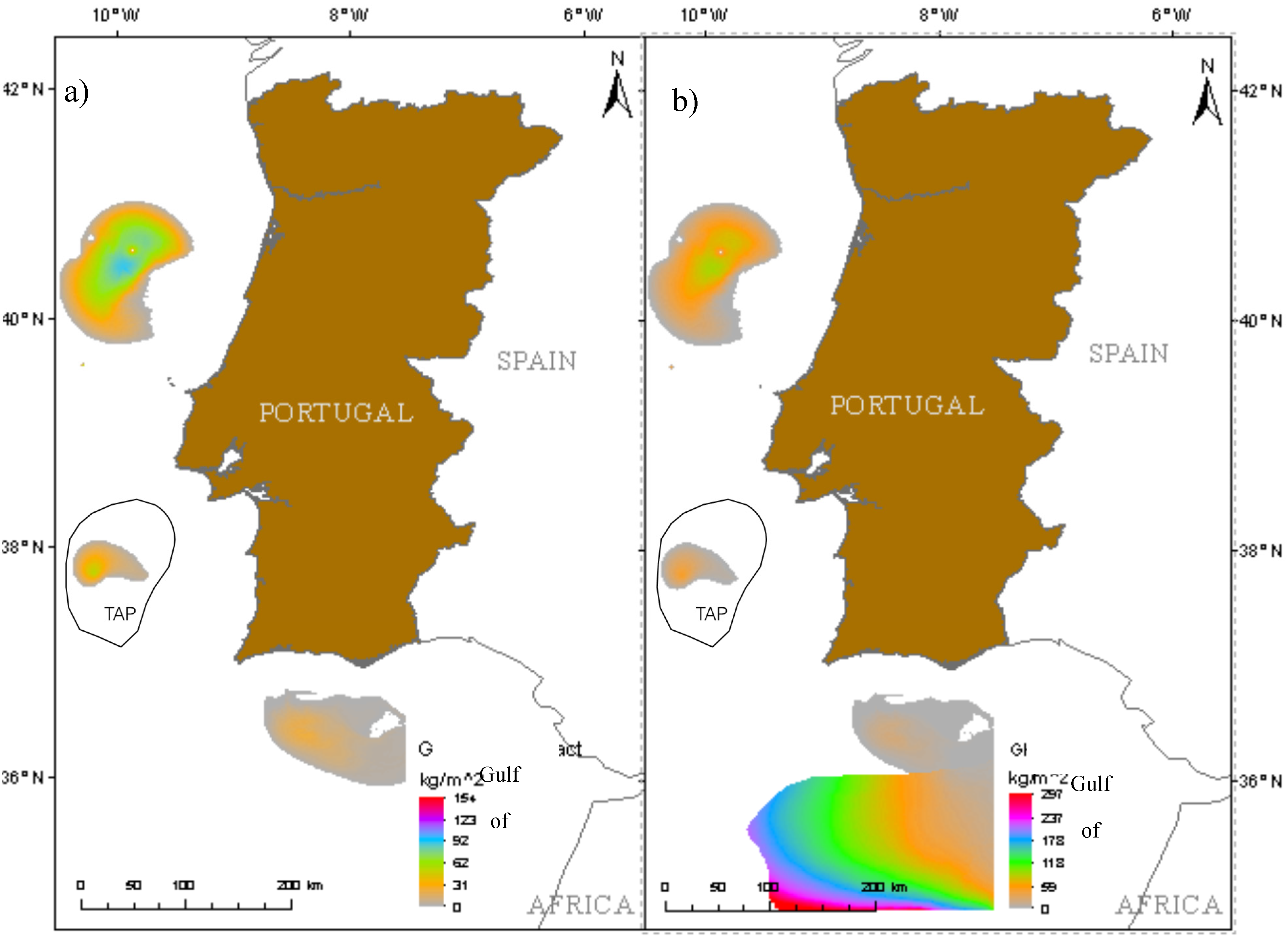
5. Discussion
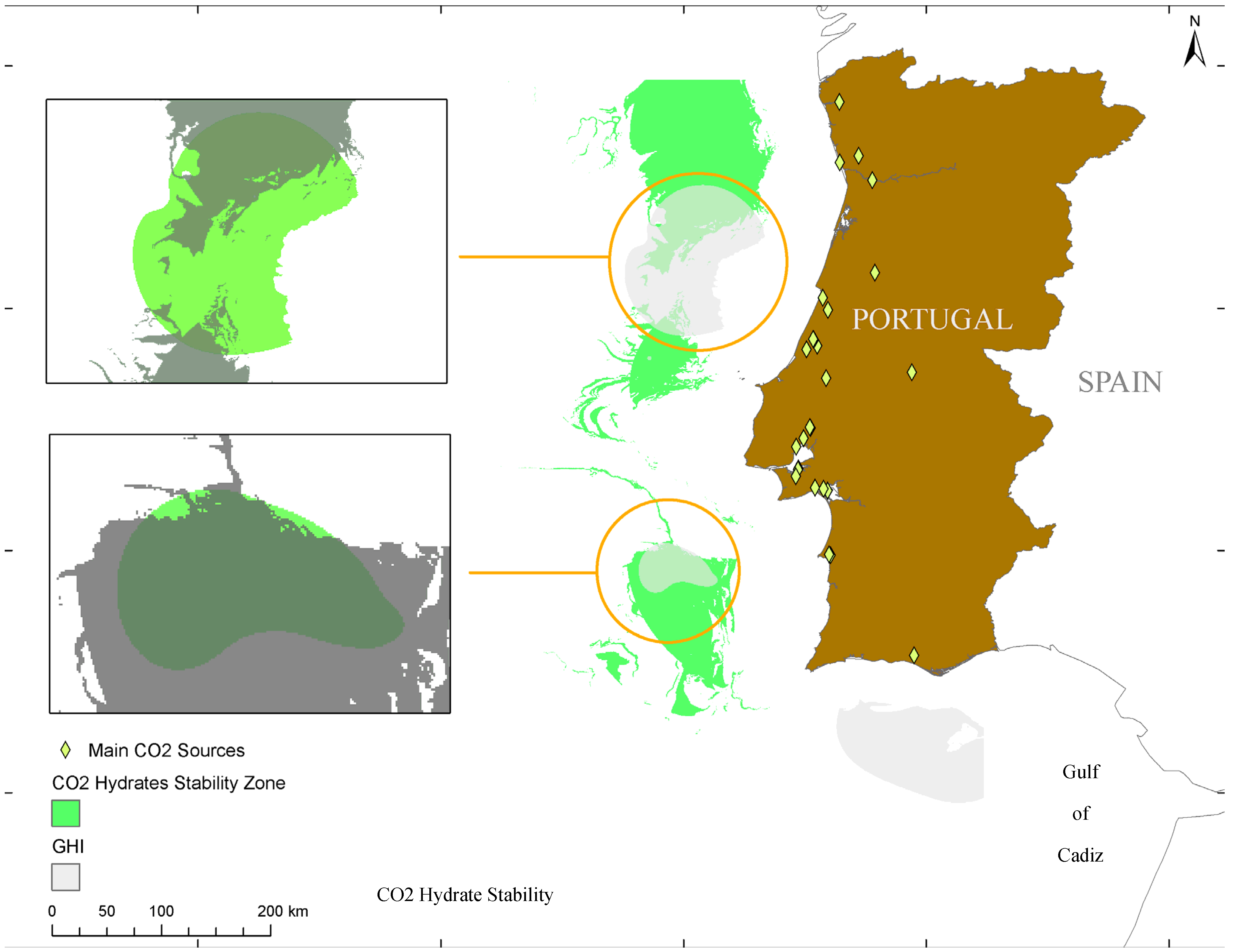
6. Conclusions
Acknowledgments
Author Contributions
Conflicts of Interest
References
- IPCC. Climate Change 2007: Impacts, Adaptation and Vulnerability. In Contribution of Working Group II to the Fourth Assessment Report of the Intergovernmental Panel on Climate Change; Cambridge University Press: Cambridge, UK, 2007; p. 976. [Google Scholar]
- IEA. Key World Energy Statistics 2009; IEA: Paris, France, 2009; p. 82. [Google Scholar]
- Koide, H.; Takahashi, M.; Tsukamoto, H.; Shindo, Y. Self-Trapping Mechanisms of Carbon-Dioxide in the Aquifer Disposal. Energy Convers. Manag. 1995, 36, 505–508. [Google Scholar] [CrossRef]
- Li, X.; Ohsumi, T.; Koide, H.; Akimoto, K.; Kotsubo, H. Near-future perspective of CO2 aquifer storage in Japan: Site selection and capacity. Energy 2005, 30, 2360–2369. [Google Scholar] [CrossRef]
- Bernardes, L.F.; Carneiro, J.; de Abreu, M.P. CO2 hydrates as a climate change mitigation strategy: Definition of stability zones in the Portuguese deep offshore. Int. J. Glob. Warm. 2013, 5, 135–151. [Google Scholar] [CrossRef]
- Schoder, D.H.F.; Hester, K.; Howard, J.; Ratermant, S.; Lloyd Martin, K.; Smith, B.; Klein, P. ConocoPhilips (2013) Gas Hydrate Production Test Final Technical Report; NETL: Houston, TX, USA, 2013.
- Lorenson, T.D.; Kvenvolden, K.A. A Global Inventory of Natural Gas Hydrate Occurrence (Map). U.S. Geological Survey 2007. Available online: http://walrus.wr.usgs.gov/globalhydrate/ (accessed on 19 April 2015).
- Milkov, A.V.; Sassen, R. Economic geology offshore gas hydrate accumulations and provinces. Mar. Pet. Geol. 2002, 19, 1–11. [Google Scholar] [CrossRef]
- Mazurenko, L.L.; Soloviev, V.A.; Gardner, J.M. Hydrochemical features of gas hydrate-bearing mud volcanoes, offshore Morocco. In Proceedings of the International Conference Geological Processes on European Continental Margins, IOC/UNESCO Workshop Report 168, Granada, Spain, 31 January–3 February 2000; pp. 18–19.
- Hensen, C.; Nuzzo, M.; Hornibrook, E.; Pinheiro, L.M.; Bock, B.; Magalhães, V.H.; Brückmann, W. Sources of mud volcano fluids in the Gulf of Cadiz—Indications for hydrothermal imprint. Geochim. Cosmochim. Acta 2007, 71, 1232–1248. [Google Scholar] [CrossRef]
- Niemann, H.; Duarte, J.; Hensen, C.; Omoregie, E.; Magalhães, V.H.; Elvert, M.; Pinheiro, L.M.; Kopf, A.; Boetius, A. Microbial methane turnover at mud volcanoes of the Gulf of Cadiz. Geochim. Cosmochim. Acta 2006, 70, 5336–5355. [Google Scholar] [CrossRef]
- Thakur, N.K.; Sanjeev, R. Exploration of Gas Hydrates; Springer-Verlag: Berlin/Heidelberg, Germany, 2011; pp. 42–85. [Google Scholar]
- Sloan, E.D. Fundamental Principles and Applications of Natural Gas Hydrates. Nature 2003, 426, 353–359. [Google Scholar] [CrossRef] [PubMed]
- Kvenvolvden, K.A.; Claypool, G.E. Gas Hydrates in Oceanic Sediment; U.S. Geological Survey: Reston, VA, USA, 1998; pp. 88–216.
- Collet, T.S. Gas Hydrates of the United States, in 1995 National Assessment of United States Oil and Gas Resources, USGS Digital Data Series, 30, on CD-ROM; Gautier, D.L., Dolton, G.L., Takahasshi, K.I., Varnes, K.L., Eds.; USGS: Reston, VA, USA, 1995; p. 85.
- Klauda, J.B.A.; Sender, S.I. Global distribution of methane hydrate in Ocean Sediment. Energy Fuel 2005, 19, 459–470. [Google Scholar] [CrossRef]
- Burwickz, E.; Rupke, L.H.; Wallmann, K. A new global gas hydrate budget based on global inventory of methane hydrates in marine sediments using transfer functions. Biogeosciences 2011, 10, 959–975. [Google Scholar]
- Wallmann, K.; Pinero, E.; Burwicz, E.; Haeckel, M.; Hensen, C.; Dale, A.; Ruepke, L. The Global Inventory of Methane Hydrate in Marine Sediments: A Theoretical Approach. Energies 2012, 5, 2449–2498. [Google Scholar] [CrossRef]
- Piñero, E.; Marquardt, M.; Hensen, C.; Haeckel, M.; Wallmann, K. Estimation of the global inventory of methane hydrates in marine sediments using transfer functions. Biogeosciences 2013, 10, 959–975. [Google Scholar] [CrossRef]
- Pollack, H.N.; Hurter, S.J.; Johnson, J.R. Heat flow from the Earth’s interior: Analysis of the global data set. Rev. Geophys. 1993, 31, 267–280. [Google Scholar] [CrossRef]
- Hamza, V.M.; Cardoso, R.R.; Ponte Neto, C.F. Spherical harmonic analysis of the earth’s conductive heat flow. Int. J. Earth Sci. 2008, 97, 205–226. [Google Scholar] [CrossRef]
- Marquardt, M.; Hensen, C.; Piñero, E.; Haeckel, M.; Wallmann, K. A transfer function for the prediction of gas hydrate inventories in marine sediments. Biogeosciences 2010, 7. [Google Scholar] [CrossRef]
- Leon, R.; Somoza, L.; Gimenez-Moreno, C.J.; Dabrio, C.J.; Ercilla, G.; Praeg, D.; Diaz-del-Rio, V.; Gomez-Delgado, M. A predictive numerical model for potential mapping of the gas hydrate stability zone in the Gulf of Cadiz. Mar. Petrol Geol. 2009, 26, 1564–1579. [Google Scholar] [CrossRef]
- Zitellini, N.; Gràcia, E.; Matias, L.; Terrinha, P.; Abreu, M.A.; DeAlteriis, G.; Henriet, J.P.; Dañobeitia, J.J.; Masson, D.G.; Mulder, T.; et al. The quest for the Africa—Eurasia plate boundary west of the Strait of Gibraltar. Earth Planet. Sci. Lett. 2009, 280, 13–50. [Google Scholar] [CrossRef]
- Medialdea, T. Estructura y Evolución Tectónica del Golfo de Cádiz Pub; Serie Tesis Doctorales; Instituto Geológico y Minero de España: Madrid, Spain, 2007; Volume 8, p. 382. (In Spanish) [Google Scholar]
- Gardner, J.M.; Vogt, P.R.; Somoza, L. The possible effect of the Mediterranean Outflow Water (MOW) on gas hydrate dissociation in the Gulf of Cadiz. EOS Trans. AGU 2001, 82. Abstracts OS12B-0418. [Google Scholar]
- Somoza, L.; Díaz del Río, V.; Hernandez-Molina, F.J.; Leo, R.; Lobato, A.; Alveirinho, J.M.; Rodero, J.; TASYO Team. New discovery of a mud-volcano field related to gas venting in the Gulf of Cadiz: Imagery of multibeam data and ultra-high resolution data. In Proceedings of the Final Proceedings 3rd International Symposium Iberian Atlantic continental margin, Faro, Portugal, 25–27 September 2000; pp. 397–398.
- Sloan, E.D.; Koh, C.A. Clathrate Hydrates of Natural Gases, 3rd ed.; CRC Press: Boca Raton, FL, USA, 2008; p. 720. [Google Scholar]
- Benazzouz, O. Gas hydrates stability domains in the Portuguese Margin. The Gulf of Cadiz and the West Alboran SEA. Master’s Thesis, Faculty of Science and Technology, Geosciences Department, University of Abdelmalek Essadi, Tangier, Marroco, October 2011. [Google Scholar]
- Thiede, J.; Ehrmann, W.U. Late Mesozoic and Cenozoic sediment flux to the central North Atlantic Ocean. Geol. Soc. Spec. Publ. 1986, 21, 3–15. [Google Scholar] [CrossRef]
- Broecker, W.S.; Klas, M.; Clark, E.; Bonani, G.; Ivy, S.; Wolfli, W. The influence of CaCO3 dissolution on core top radiocarbon ages for deep-sea sediments. Paleoceanography 1991, 6, 593–608. [Google Scholar] [CrossRef]
- Thomson, J.; Nixon, S.; Summerhayes, C.P.; Schönfeld, J.; Zahn, R.; Grootes, P.M. Implications for sedimentation changes on the Iberian margin over the last two glacial/interglacial transitions from (230Th-excess)0 systematics. Earth Planet. Sc. Lett. 1999, 165, 255–270. [Google Scholar] [CrossRef]
- Sarnthein, M.; Winn, K.; Jung, S.J.A.; Duplessy, J.; Labeyrie, L.D.; Erlenkeuser, H.; Ganssen, G.M. Changes in east Atlantic deepwater circulation over the last 30,000 years: Eight time slice reconstructions. Paleoceanography 1994, 9, 209–267. [Google Scholar] [CrossRef]
- Voelker, A.H.L.; Lebreiro, S.M.; Schönfeld, J.; Cacho, I.; Erlenkeuser, H.; Abrantes, F.F. Mediterranean outflow strengthening during northern hemisphere coolings: A salt source for the glacial Atlantic? Earth Planet. Sc. Lett. 2006, 245, 39–55. [Google Scholar] [CrossRef]
- Alt-Epping, U. Late Quaternary sedimentation processes and sediment accumulation changes off Portugal. Ph.D. Thesis, Elektronische Dissertationen an der Staats- und Universitätsbibliothek Bremen, Germany, 2008; pp. 1–169. [Google Scholar]
- Suess, E. Particulate organic carbon flux in the oceans—Surface productivity and oxygen utilization. Nature 1980, 288, 260–263. [Google Scholar] [CrossRef]
- Martens, C.S.; Haddad, R.I.; Chanton, J.P. Organic Matter Accumulation, Remineralization, and Burial in an Anoxic Coastal Sediment in Organic Matter: Productivity, Accumulation and Preservation in Recent and Ancient Sediments; Whelan, J.K., Farrington, J.W., Eds.; Columbia University Press: New York, NY, USA, 1992; pp. 82–98. [Google Scholar]
- Seiter, K.; Hensen, C.; Zabel, M. Benthic carbon mineralization on a global scale. Glob. Biogeochem. 2005, 19. [Google Scholar] [CrossRef]
- Pangea Data Publisher & Environmental Science. Available online: http://www.pangea.de (accessed on 23 April 2014).
© 2015 by the authors; licensee MDPI, Basel, Switzerland. This article is an open access article distributed under the terms and conditions of the Creative Commons Attribution license (http://creativecommons.org/licenses/by/4.0/).
Share and Cite
Bernardes, L.; Carneiro, J.; Madureira, P.; Brandão, F.; Roque, C. Determination of Priority Study Areas for Coupling CO2 Storage and CH4 Gas Hydrates Recovery in the Portuguese Offshore Area. Energies 2015, 8, 10276-10292. https://doi.org/10.3390/en80910276
Bernardes L, Carneiro J, Madureira P, Brandão F, Roque C. Determination of Priority Study Areas for Coupling CO2 Storage and CH4 Gas Hydrates Recovery in the Portuguese Offshore Area. Energies. 2015; 8(9):10276-10292. https://doi.org/10.3390/en80910276
Chicago/Turabian StyleBernardes, Luís, Júlio Carneiro, Pedro Madureira, Filipe Brandão, and Cristina Roque. 2015. "Determination of Priority Study Areas for Coupling CO2 Storage and CH4 Gas Hydrates Recovery in the Portuguese Offshore Area" Energies 8, no. 9: 10276-10292. https://doi.org/10.3390/en80910276
APA StyleBernardes, L., Carneiro, J., Madureira, P., Brandão, F., & Roque, C. (2015). Determination of Priority Study Areas for Coupling CO2 Storage and CH4 Gas Hydrates Recovery in the Portuguese Offshore Area. Energies, 8(9), 10276-10292. https://doi.org/10.3390/en80910276





